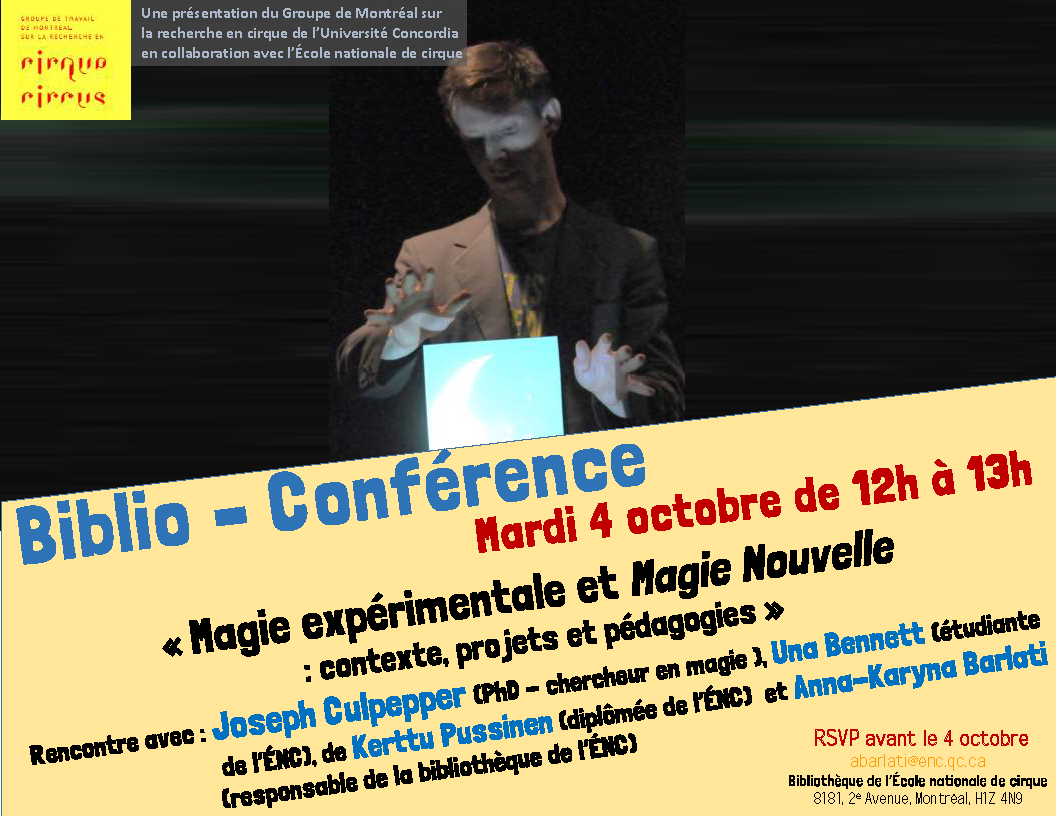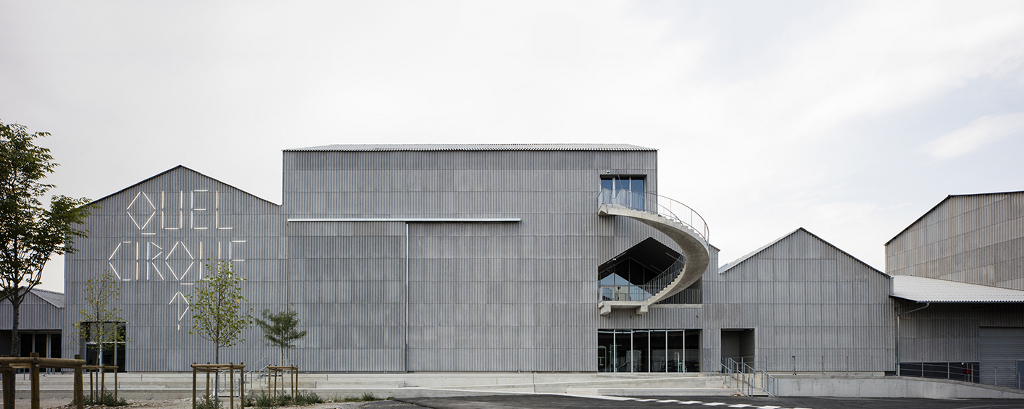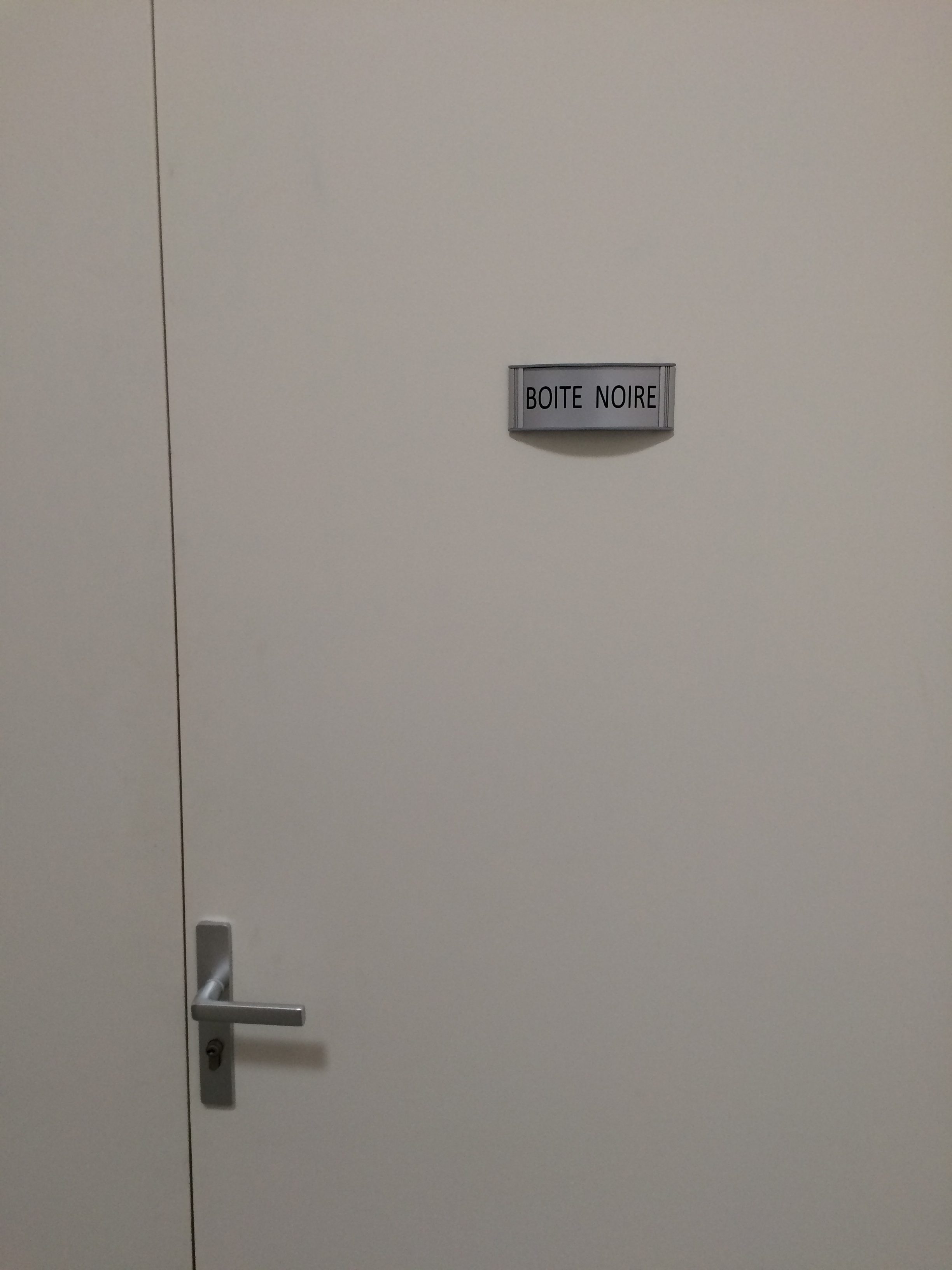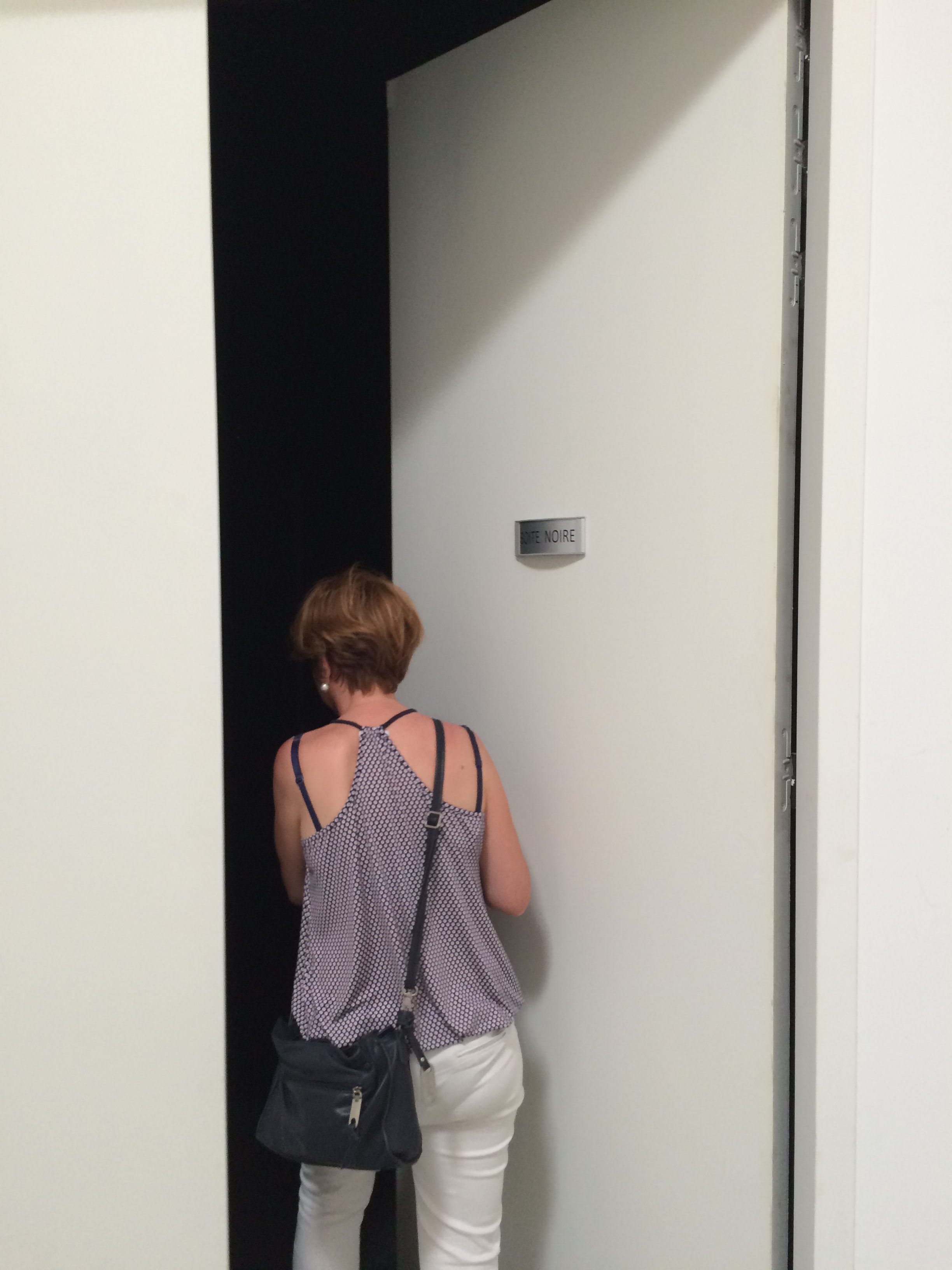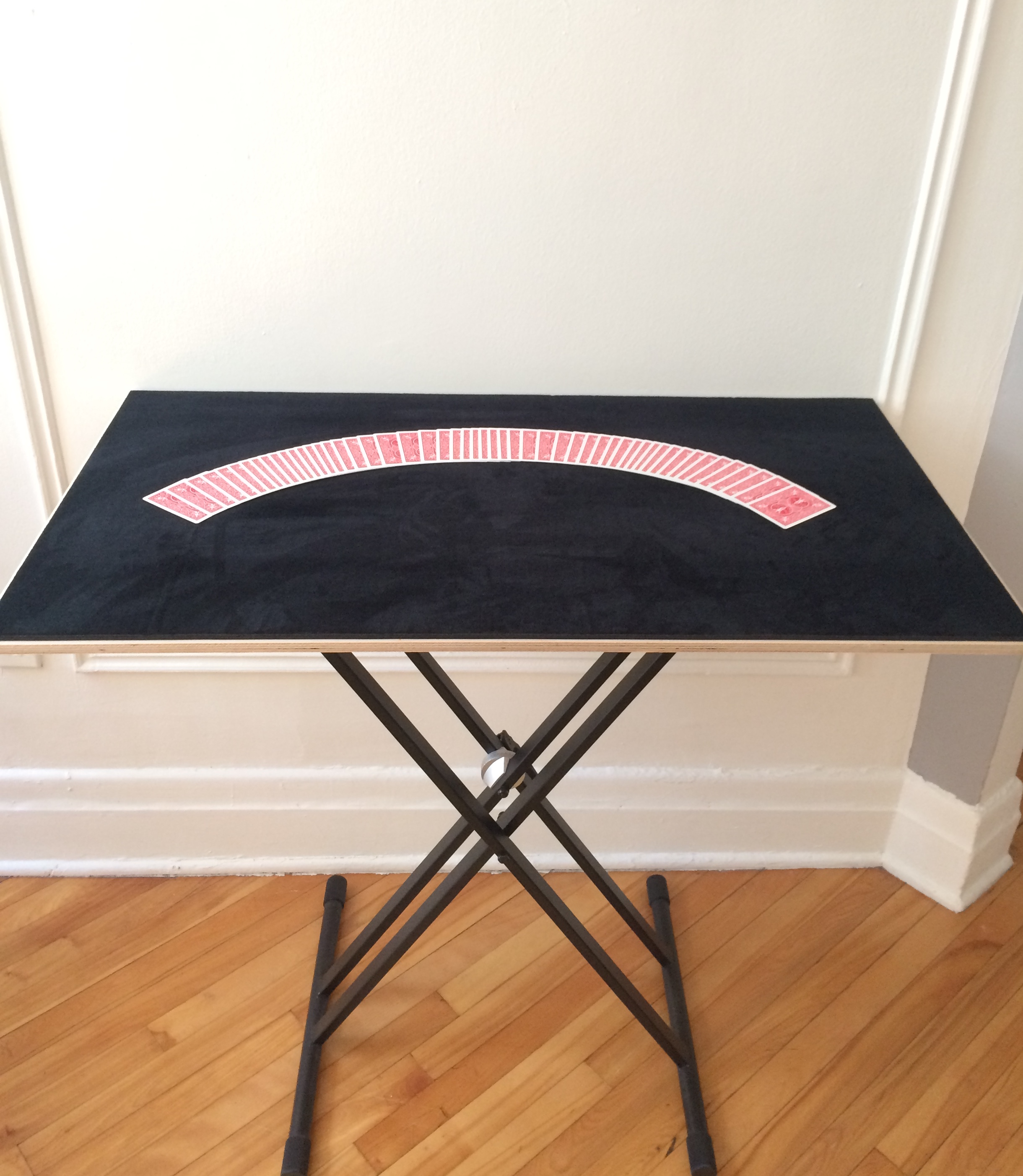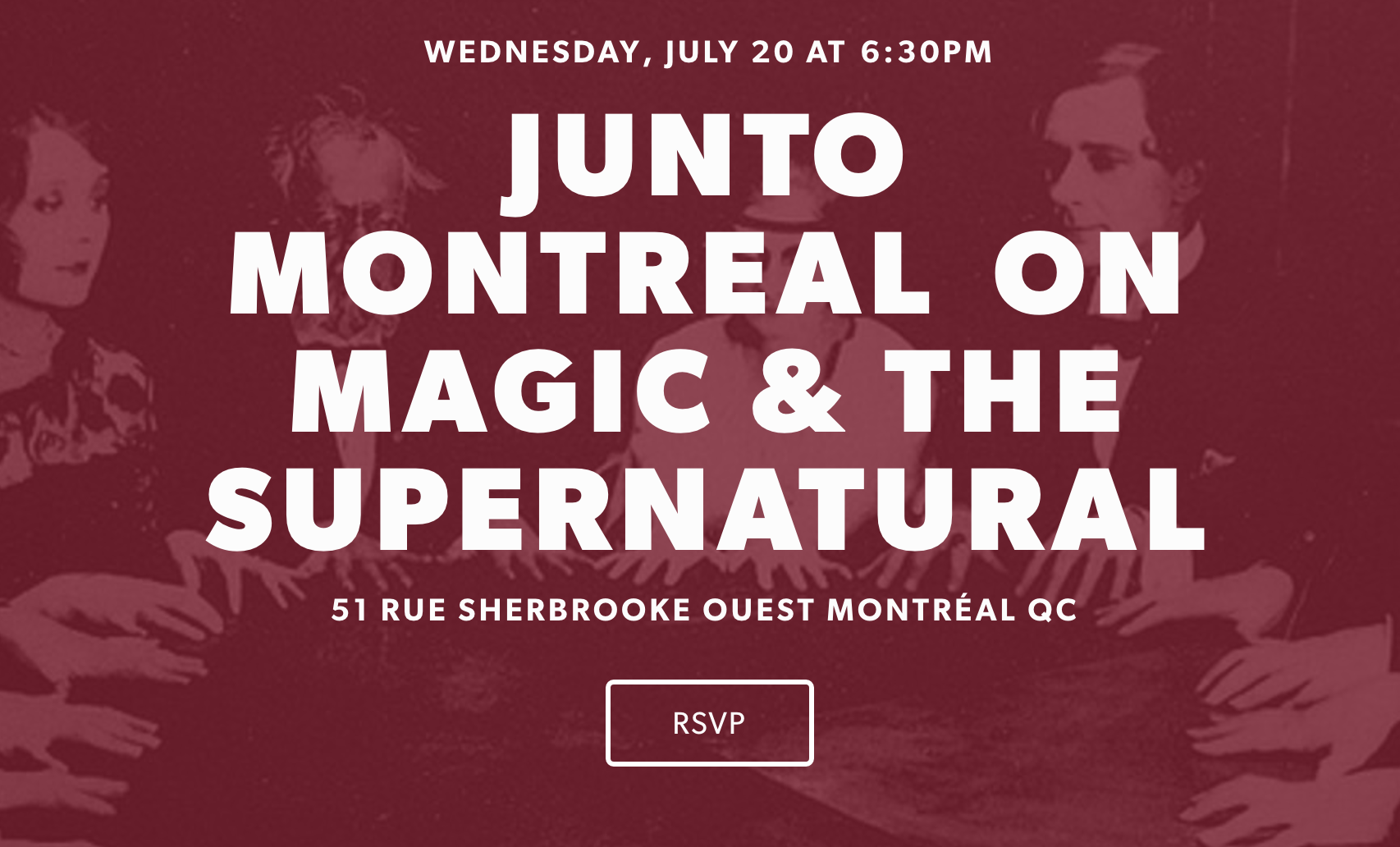I had a great time today sharing highlights from two years of practice-based research at Montréal’s National Circus School (NCS) and giving some glimpses into current projects. It was quite special to have Una Bennett (a current student), Kerttu Pussinen (a circus pro and collaborator) and Anna-Karyna Barlati (head of the library) speak about the various magic projects we work on together. The NCS, its SSHRC Industrial Research Chair for Colleges in circus arts, Patrick Leroux’s Montréal Working Group on Circus, the TOHU, and En Piste continue to be amazingly supportive partners in exploring how to adapt the performing art of magic to other circus disciplines.
Magic in France (p.2) — Magie Nouvelle in Châlons-en-Champagne
@Sebatien Normand
I’d dreamed of visiting this French circus school for four years to learn more about its magie nouvelle (“new magic”) programme. Earlier this month, I finally got my chance. Its name translates to the National Centre for the Circus Arts, but I’ll use its native acronym here and just call it the CNAC, Châlons-en-Champagne. The CNAC is one of the world’s few state-funded circus schools from which students graduate with a diploma in the circus arts. It is the only school I know, which uses government funding to offer a one-year certification program in “new magic” — an interdisciplinary hybrid of traditional magic techniques and contemporary circus. What’s even more impressive is that a few years ago the CNAC turned military funding into circus funding — by reallocating a windfall of euros previously used for armaments to fund a huge expansion of its circus arts buildings. This transformation of arms into arts is beautiful. Maybe instead of shooting one another we should be performing for one another?
You can see many stunning photos of the 2015 expansion in a French architecture article here. Below are some of my snapshots of the CNAC library and la boite noire, “the black box.”
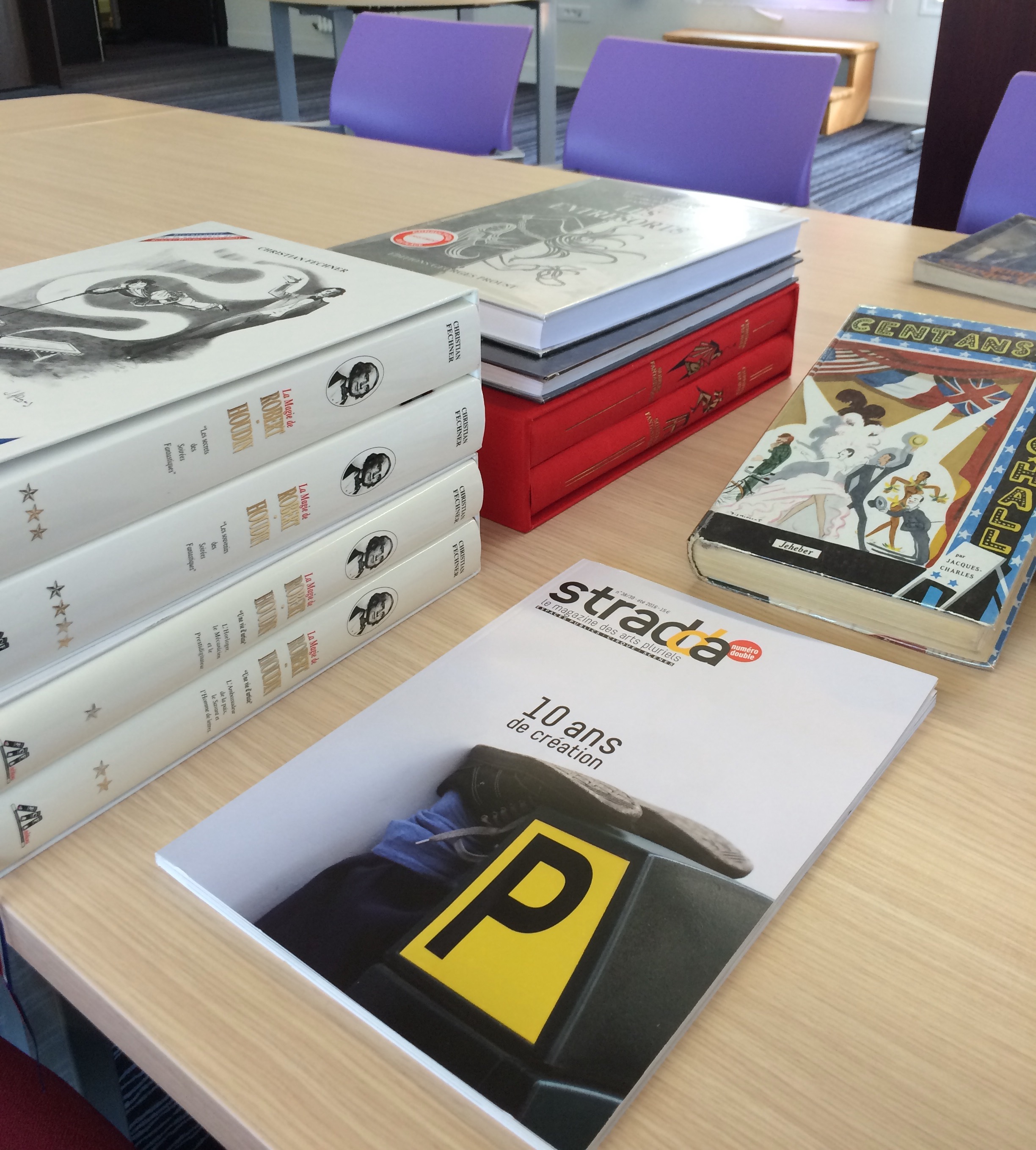 I would like to thank Gérard Fasoli, Cyril Thomas, Barbara Appert-Raulin, Jeanne Vasseur, and the entire CNAC team for being wonderful hosts during my research visit. I would also like to thank Patrice Aubertin and the National Circus School (NCS henceforth) of Montreal for making this research trip possible. The CNAC library contains over 300 magic texts, including rare, French-language and magie nouvelle items that are hard to find elsewhere. I spent three days reading, watching and taking as many notes as I could onsite. My final treat was a peek inside the black box magie nouvelle creation space:
I would like to thank Gérard Fasoli, Cyril Thomas, Barbara Appert-Raulin, Jeanne Vasseur, and the entire CNAC team for being wonderful hosts during my research visit. I would also like to thank Patrice Aubertin and the National Circus School (NCS henceforth) of Montreal for making this research trip possible. The CNAC library contains over 300 magic texts, including rare, French-language and magie nouvelle items that are hard to find elsewhere. I spent three days reading, watching and taking as many notes as I could onsite. My final treat was a peek inside the black box magie nouvelle creation space:
As Gordon Bean and Bill Goodwin once wrote: “No door is as fascinating as the locked one.”I can’t tell you exactly what’s inside, but I will say that it’s a collection of very exciting research and development tools. The future of magic and circus experiments is bright thanks to schools like the CNAC and the NCS in Montreal.
Circus, Quantum Mechanics, Magic: Collaboration w/Kerttu Pussinen
I’m excited to announce a collaboration with National Circus School graduate and professional Finnish circus artist, Kerttu Pussinen. Just two years after graduating from the NCS, Kerttu is working on her first solo show — Particle # B. The show will use circus arts, magic effects and more to visualize principles of physics and quantum mechanics. This is exactly the kind of interdisciplinary experimentation that motivates me as a magic consultant, so I am thrilled to be part of the show’s creative team. With generous support from the Finnish Cultural Foundation and the TOHU, Particle # B begins its first creation residency in Montréal on October 1st, 2016. Kerttu and I will be speaking about our collaboration at the Fields Institute for Research in Mathematical Sciences this Thursday evening in Toronto. Please click here to RSVP if you would like to attend this LASER Toronto event.* It would be lovely to see Toronto friends there. In particular, I would like to encourage those of you with a strong interest in physics, quantum mechanics and the performing arts to attend.
* Special thanks to the facilitators of this free event for making our participation possible: Antje Budde (Digital Dramaturgy Lab, Institute for Digital Humanities in Performance at the Centre for Drama, Theatre and Performance Studies), Nina Czegledy (LASER/Leonardo Network), Roberta Buiani (ArtSci Salon, Fields Institute), and Don Sinclair (Computational Arts at York University).
Magic in France (p.1) — Deceptive Arts in Cerisy-la-Salle
The first busy weeks of September have begun, but I’m often still thinking about the wonderful research trip I had in France from August 21st to September 4th. It was so inspiring that I’ll be making a few posts this month to share what I learned in Cerisy-la-Salle, Châlons-en-Champagne, and Paris.
First, I’d like to thank Jean-Marc Larrue, Giusy Pisano, and Frank Kessler for their kind invitation to spend nearly a whole week sharing academic magic research at the historic chateau of Cerisy-la-Salle, France. What a place to write and think! Their research group — The Deceptive Arts — is filled with historians from a variety of disciplines and countries who are working on magic as either a performing art or a cultural concept.
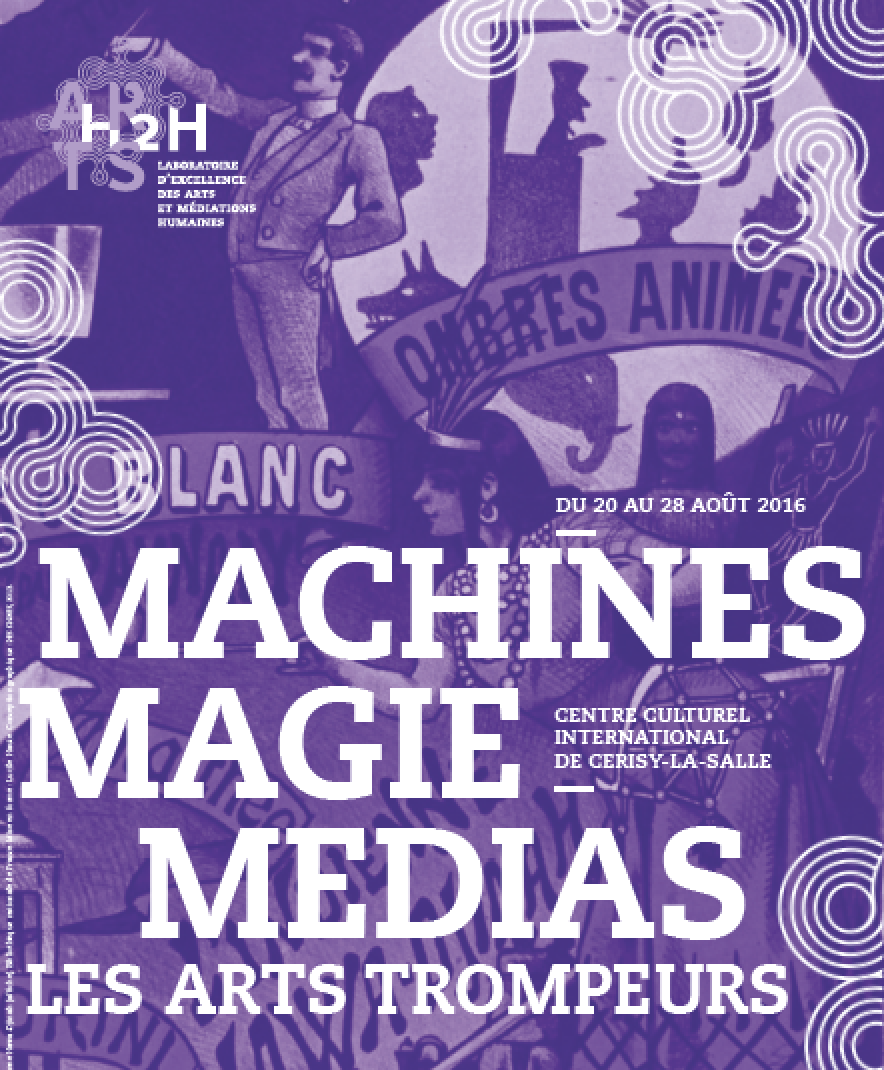
I gathered a wealth of new information from these fascinating people. All of our papers will be published in French and our oral presentations were recorded by the Centre culturel international de Cerisy-la-Salle. All quite exciting for a longtime francophile like myself.
The Magic Table: A Miniature Stage
Here is the minimalist and portable magic table that I’ve been working on for months as a side project. After considering dozens of different retail tables and construction plans, I decided to build my own using strong, light and elegant material. The stand is designed to hold the weight of a keyboard and can be adjusted to various heights or folded completely flat.The board is 1/2 an inch of Russian pine. The surface is black velvet plush. I wanted to create a large performance space (20″ by 40″) to make a close-up magic stage that would also be suited to small-pitch work on the street or indoors. I’m considering adding a simple frame or some decorative trim to the edges of the table, but there is something nice about a simple and thin design. It conveys openness and makes the appearance, disappearance and transformation of objects more magical. If others have favorite tables for this kind of performance, I’d love to see them.
“Magic and the Supernatural”
I’ll be giving a public presentation based on my most recent research and magic consultation project next week. This praxis performance will include supernatural magic effects inspired by my childhood experiences at a spiritual summer camp, Harry Houdini’s 1926 anti-spiritualist exposé at McGill University, and my collaboration on the new media webseries Houdini and Doyle: World of Wonders. All are welcome to attend and to participate in an open discussion after the talk.
Click here or on the image above for event details and the link to RSVP.
Jazz, Technique and Oliver Jones
“Even a single note can swing.”
— Count Bassie
“Everything has a touch.”
— Dai Vernon
I had the distinct pleasure of watching jazz legend Oliver Jones play songs like “Gershwin Medley” at his final performance for the Montreal Jazz Festival on Thursday. A master is retiring. The hands of Jones, mentored by the late, great Oscar Peterson, have a sort of superhuman dexterity when they touch the piano. The sound of him playing was magical, transporting the ears and minds of roughly 1,900 people at the sold out Maison symphonique. Watching a virtuoso perform with that level of technique at 81 is inspiring. “Gershwin Medley” makes me think about three things that link jazz and magic as performing arts: the touch of a master, the hours of dedicated practice required to achieve it, and the delicate art of adding new personality to classics.
Watching Spanish magician Juan Tamariz perform in Sacramento in 1997 was the first time I saw the hands of a master magician performing up-close and in person. It’s difficult to describe, but I think that spectators instinctively sense when they are watching a master perform based on the way the tools are handled. For Oliver Jones, it’s the piano. For Tamariz, it’s the deck of playing cards. The difference, of course, is that the jazz pianist displays overt skill and the magician displays overt effects — magic — while concealing skill. Despite this contrast, spectators see both performers handle instruments and are often able to judge whether or not the artists’s interactions with those objects are masterful. As magic master Dai Vernon put it so beautifully: “Everything has a touch.” To develop a touch similar to that of Jones or of Tamariz, however, requires a lifetime of practice.
David Ben has written extensively on the work of Dai Vernon and was mentored by Canadian master magician Ross Bertram. Years ago, Ben wrote a post about “dedicated practice” as an approach for acquiring a high level of technical skill. The phrase doesn’t mean just logging many hours, but doing so with keen attention to structure and reflection to correct mistakes in the rehearsal studio. I think of this as the more one practices, the better one must get at practicing efficiently — or practice smarter, not harder.
For me, watching Ben perform Bertram’s magic is like watching Jones perform Peterson’s music. I never saw Bertram or Peterson perform live. They each passed away before I had the chance to see them, but I love reading, watching and listening to recordings of their work. Their material, in the hands of their students, combines the past touch of the master with the current touch of the protégé.
In both magic and music, I see the newer generation paying homage to the one before while carefully adding their own personalities — their own touch.
Getting Into Swallowing Needles: A Collaborative Effort
“The East Indian Needle Trick” is what Houdini typically called it. How to adapt it for a three-minute webisode with actress Rebecca Liddiard and magician Scott Hammell was our challenge. We had many ideas for setting the stage of this episode: filming it on-location in a tailor’s shop, a tattoo parlor, etc. Ciara Vernon, our talented production designer, came up with the great solution we chose in the end. She and her team created a needle and thread art installation on set. It was beautiful to watch and walk through this piece of art. You’ll see Rebecca collect needles from this virtual hanging forest of sharp metal in the clip below. Then, you’ll see Scotty swallow them:
*P.S. You can catch the latest Houdini & Doyle TV episode tonight at 9/8c on FOX and GlobalTV
Houdini & Doyle: World of Wonders on KindaTV
Good news! All ten episodes of the Houdini & Doyle: World of Wonders webseries are now viewable outside of Canada. Follow the KindaTV link below to watch host Rebecca Liddiard as she delves into magic history and various effects. Thanks to John Cox and @miss_steph42 for the update on this. You can catch the latest Houdini & Doyle TV episode tonight at 9/8c on FOX and GlobalTV:
Hypnotism Posters c.1900?
A McGill colleague recently sent me these wonderfully quirky posters depicting fin-de-siecle hypnotism shows. I’m not sure who penned this post at The Public Domain Review, but it looks to me like these are probably stock posters for entertainment hypnotists who couldn’t afford to have original, custom posters designed. The blank space at the top is for the insertion of the performer’s name. There was a market for stock magic posters during this era as well. In fact, the fourth poster in this the site’s post looks more like a second sight act than a hypnotism number:
The Donaldson Litho Company (Newport, Kentucky) printed a few different magic stock posters and at least one personalized design for the magician known as Kar-mi (The Prince of India). Does anyone have other favorite Donaldson Litho posters?
